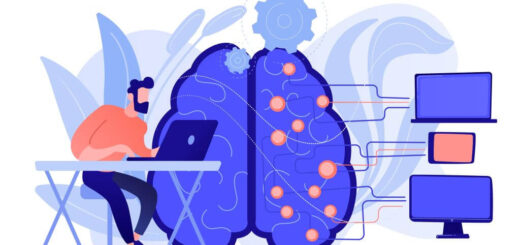Customer service AI and chatbot: what it means for modern business

It’s doubtless that the number of companies using AI-powered customer service will keep growing, and we will see artificial intelligence solutions being an essential part of corporate CRM (customer relationships management) strategy in the next few years.
Businesses are adopting customer service AI (artificial intelligence) chatbots and assistants more than ever before. From online stores setting up AI-driven recommender systems to guide shoppers through the buying journey, to product companies using automated chatbot services to improve user experiences, artificial intelligence is being scaled across various industries at an enterprise level.
No longer a nascent technology, AI-powered cognitive systems and chatbots can spot hidden trends and provide valued insights to help customer service teams improve workflows and customer experiences in real time.
In this article, I want to examine what it means for modern businesses to use customer service AI. I will walk through the definitions of conversational AI and discover how businesses across industries can adopt artificial intelligence chatbost and virtual agents to engage customers more effectively.
What is Customer Service AI?
Customer service artificial intelligence is a conversation AI system that helps businesses provide clients and prospects with fast, straightforward and accurate answers to their questions, across any application, channel or device. This AI automates responses to common inquiries and use cases so that reducing the burden on customer service representatives and the risk of disruption during peak times. With customer AI systems in place, human agents focus on complex issues and non-repetitive responses, and customers get faster replies to their queries day or night.

There are three key definitions that describe conversational AI:
- Intent – a specific goal or idea the customer wants to do or wants to happen.
- Context – describes the situation when, where and how the intent will happen. If the customer intends to find a restaurant or facility nearby, the context encompasses the customer’s location, device, local time, and other variables.
- Conversation – a human-to-machine dialog based on conditional and “tree” logic to process the customer’s intents expressed in this dialog. Conversations can be grouped into nodes that define what response the AI system returns back to the customer.
Using conversational AI customer service bots, business are able to complete the following tasks:
- Discover and understand what consumers really want
- Automate workflows and repetitive tasks of human agents
- Scale customer service while getting high satisfaction and engagement rates
How does Conversational AI Improve Customer Service?
Besides providing fast, consistent responses to customer queries for visual (for augmented reality or virtual reality environments), voice and text-based communications, customer service conversational AI solutions keep interactions intuitive and helpful, using AI technologies and capabilities to help customers get support and resolution quickly and effectively.
Here below are three ways how AI helps businesses improve customer service and support:
1. Automated customer experience.
Thanks to customer service automation, human agents solve even the most complex issues and provide support service to more customers, which leads to improved customer engagement and higher satisfaction rates. As you spend less time on repetitive and low priority inquiries you streamline workflows and improve customer service expertise.
2. More insights from customer data.
With conversational AI solutions in place, you can identify opportunities that might otherwise be missed with an FAQ chatbot solution. AI collects and analyzes customer data (text messages, calls, emails, chats) and provides customer service agents with actionable insights so they can properly align and prioritize your customer service strategy.
3. Reduced operating costs and accelerated resolutions.
AI-enabled NLU and neural networks make it possible to process more customer questions, faster, leading to reduced operating costs and simpler deployments. Live human agents are empowered to reply to customer requests faster and with greater confidence. AI pulls resolutions from an internal knowledge base and automates customer service workflows via web and mobile channels.

Conversational AI vs. Traditional Chatbots (FAQ Bots)
Traditional chatbots (or frequently-asked-questions bots) for customer support simply scan a conversation for general keywords and provide responses based on common phrases obtained from an associated library or FAQ database. These chatbots generate linear conversation flows and try to mimic human interactions, frustrating clients when a misunderstanding arises.
Conversational AI is more than a traditional chatbot solution. Thanks to NLP and deep learning built in, this AI knows when to search for an answer from a knowledge base, when to clarify the question, and when to direct customers to a live support agent. And as it’s been mentioned earlier, conversation AI platforms use intents, context and conversation nodes behind the scene to connect clients to the right information across voice to web chat to messaging channels, without getting customer care agents involved in the conversation.
Conversational AI versus FAQ bots
| FAQ bots | Conversational AI |
| Rule-based | Machine learning and deep learning |
| Linear | Intent-driven |
| Text communication (text chat) | Multi-modal communication |
| Scripted responses | Omnichannel |
AI technologies that make customer experience smarter
The sophistication of AI-powered customer service software is largely determined by the technologies being used on the back-end. Through the comprehensive application of cloud computing, big data and algorithms, customer service AI companies like Microsoft, Google and Apple democratize advanced AI technologies to make it easier for businesses to build and deploy artificial intelligence solutions.
An example of these efforts is Microsoft Xiaoice, an empathetic AI-based chatbot that provides emotional support to more than 660 million users in China. It’s also trained to write poems, paint and compose music.

Customers can ask and get replies from an AI-powered virtual assistant via text, voice and vision communications thanks to these key AI technologies:
1. Machine learning (ML) that entails training computers to perform specific tasks with a combination of data analysis and probability (algorithms) rather than following a strictly prescribed approach. ML makes machines intelligent by allowing to learn and develop independent “thinking” to perform limited functions (known as “narrow AI”).
2. Deep learning and neural networks that emulate the interconnection of neurons in the human brain. This AI technology creates a complex network of discrete ML layers that all connect to, and impact, each other. For example, it can be a deep learning chatbot that converses with customers and learns to provide relevant answers based on everything the chatbot gets from human-to-human dialogues.
3. Natural language processing (NLP) and natural language understanding (NLU) describe an AI-powered machine’s ability to ingest what a customer says, understand the context of the conversation and comprehend its meaning, and respond back in a language the customer will understand. Thanks to these customer AI technologies, chatbots classify intents, retrieve relevant responses and extract entities to ensure smooth and human-live conversational experiences
Adopting conversational AI in customer service: Three essential steps
Based on my research across leading enterprise-level AI SaaS solutions like Amazon Comprehend, Oracle AI and IBM Watson, I separate the process of adopting AI in customer service and support in three steps. First, you need to prove that artificial intelligence can really help solve some challenges in your customer service department. Next, you develop and implement an AI approach that works right for your business, and then you scale your capabilities. Let’s dive in each step.
Step #1. Identify AI’s positive impact on your business.
You can do this with an initial use case. Let’s say, you have five human agents using live chat to talk to customers and prospects on your company’s website. You want to increase customer response time while reducing cost and improving job satisfaction. Adopting an intelligently automated 24/7 chatbot solution will help process a majority of typical customer requests and give faster responses across all the channels.
That being said, you have to prove that AI brings a positive impact on customer service workflows and communications.
Step #2. Create an adoption strategy and understand how AI will change your customer service and your business itself
Now that you know that artificial intelligence will help your agents and customers, it’s time to get started. You understand that adopting AI in the customer care process will ultimately transform your business and bring tremendous value to your prospects and clients. You want to have a strategy to effectively handle this adoption and its implications.
Here are a few tips to develop and adopt a customer AI strategy:
- Know how your customers and employees will interact with AI. For example, it can be a chatbot on your website, a recommender system built in your online store, an AI-powered email assistant to help launch and optimize email campaigns, and more.
- Lay out realistic goals. Say, you want to increase customer service response time by 45%. Align your resources and skills with what you want to achieve. You will have to start small and develop iteratively.
- Find gaps and opportunities. This basically means you’re going to look at some customer service metrics (such as Average reply time, Customer satisfaction score, Average handle time, Ticket volume, etc.) to try to get a sense where you might be doing well and you might not be. Fail fast and recover to make the necessary changes
Step #3. Build your expert team or use AI SaaS solutions

To get the most of your AI strategy, you have to build a team of subject matter experts who will develop and adopt AI solutions based on your technical environment and requirements. Those are AI researchers, programmers, QA engineers, solution architects, sponsor users, project leads, data analysts, and other roles.
Your team should understand the linguistics of developing an engaging customer service AI solution for your business. The effectiveness of this team should be measured against your AI strategy and success criteria. The monthly cost of this team can range from to $5k-25k.
Alternatively, you can use AI SaaS solutions available on a monthly subscription basis. You pay a month free for this kind of customer service AI software to implement your strategy, without all the pains of having an in-house development team. Those can be IBM Watson and Google Contact Center AI, for example.
The takeaway: AI tech to transform customer care
Artificial intelligence has been making waves in customer service for already ten years. But only a few years ago AI-enabled conversational technologies allowed sales and customer service departments to take a long step forward by automating issue resolution, streamlining workflows and making communications quicker and more effective. AI is set to continue to help: human agents respond to complex queries leaving common issues and repetitive tasks to chatbots and other AI-enabled conversational solutions.
Today is the era of personalized customer experiences and enhanced customer service. In these circumstances, modern businesses must rely on technology – artificial intelligence, machine learning, deep learning, NLP, NLU, predictive analytics, big data and cloud computing. Using conversational AI and chatbots in customer service is a great way to take the plunge into this amazing technology era.
To see customer AI in action, you don’t need to build a chatbot from scratch – there are dozens of AI SaaS startups available on the market today. With the right tools, your business gains more productive employees and more satisfied customers. But the best thing about conversational AI and chatbots for customer service is that they are learning based on customer interactions and get smarter over time, so AI-driven chatbots become capable of answering the vast majority of questions, making it possible for your business to reduce operational costs and customer service budgets.










